With oil companies shutting down rigs left and right thanks to the low price of crude, Texas’ economy is finally showing some serious signs of strain. In March, it shed more than 25,000 jobs, by far the most among all 31 states where payrolls fell. (And adding insult to injury, the Lone Star State’s spiritual arch nemesis, California, tacked on almost 40,000 new jobs.) While the Texas Workforce Commission finds that only 2,800 of March’s job losses were in “mining and logging”—the umbrella category that includes pumping oil—it’s safe to say the sector’s woes led indirectly to a much greater share of the fall.
How big were last month’s losses, really? JPMorgan Chase economist Michael Feroli, who late last year suggested the oil bust could lead Texas into a regional recession, points out that “a proportional loss on the national scale would be if the U.S. lost 304,000 jobs.” That doesn’t necessarily mean Texas’ total economy is shrinking—sadly we won’t have data that can tell us for some while—but as the Wall Street Journal notes, the situation is certainly “recession-like.”
The big question is how deep the pain will become for Texas in the coming months. Optimists argue that the state’s economy is more diversified than in the 1980s, when an energy bust plunged it into a prolonged slump. But oil and gas extraction, along with the activities that support it, still make up more than 13 percent of Texas’ total economic output, nearly the same as in 1985. And while drillers themselves may only employ about 0.9 percent of the state’s workforce, their troubles tend to ripple powerfully because so many industries, such as construction, trucking, and even banking, rely on them for business. Roughnecks and engineers also tend to make good salaries, which means that layoffs in the oil fields can disproportionately hurt spending in local communities. Finally, shrinking oil-industry tax revenues could compound those problems by forcing government budget cuts and layoffs.
In the end, the Council on Foreign Relations has estimated that a 50 percent drop in the price of crude, similar to what we’ve seen in the past half year or so, would lead to a 1.2 percent employment decline for Texas. But even if that comes to pass, there is a silver lining for the state. Its unemployment rate is currently just 4.2 percent. That’s still something for California (unemployment rate 6.5 percent) to be jealous about.
